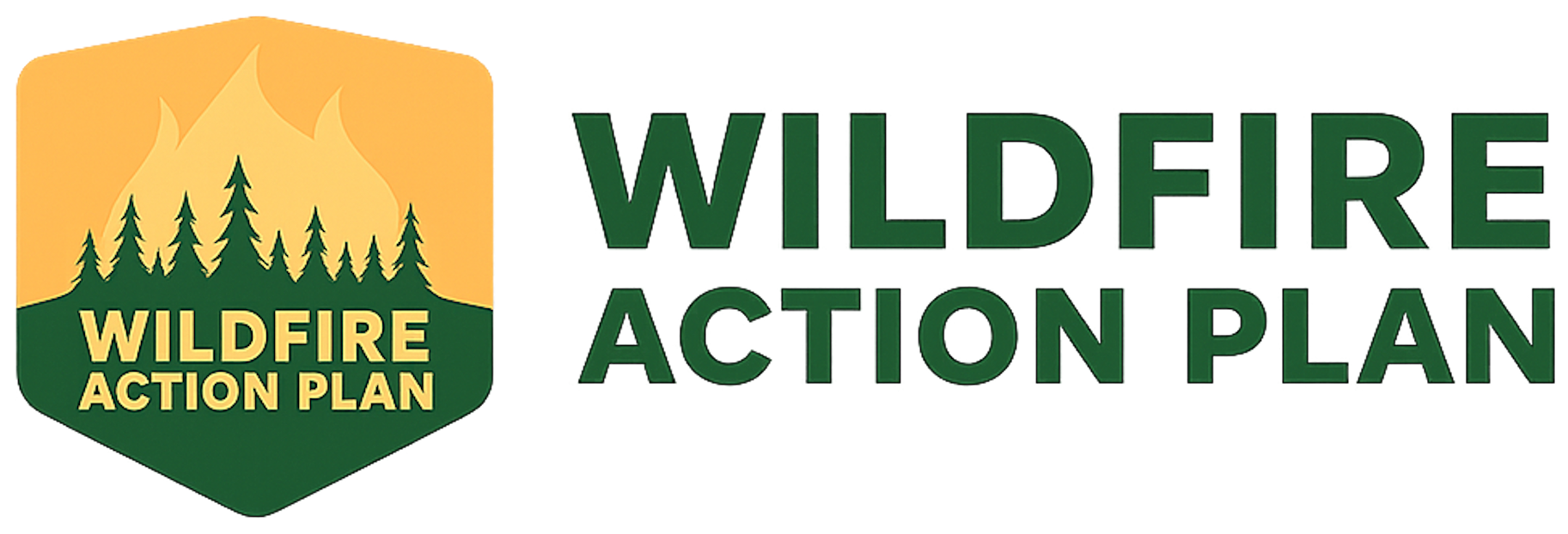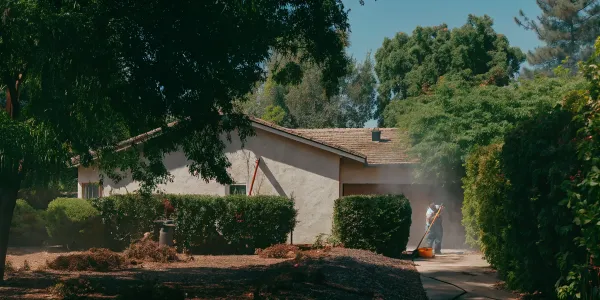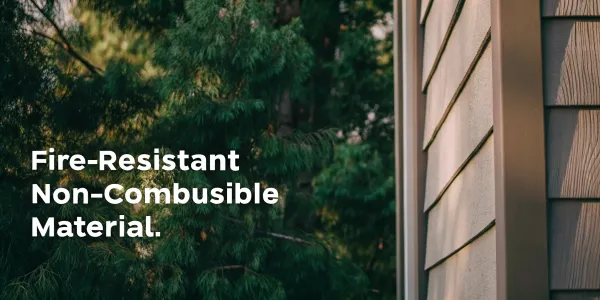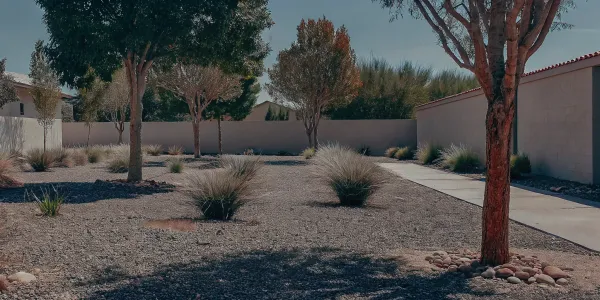How to Create Defensible Space Around Your Home: A Guide
Learn how to create defensible space around your home with practical steps, expert tips, and year-round maintenance to reduce wildfire risk and protect your property.
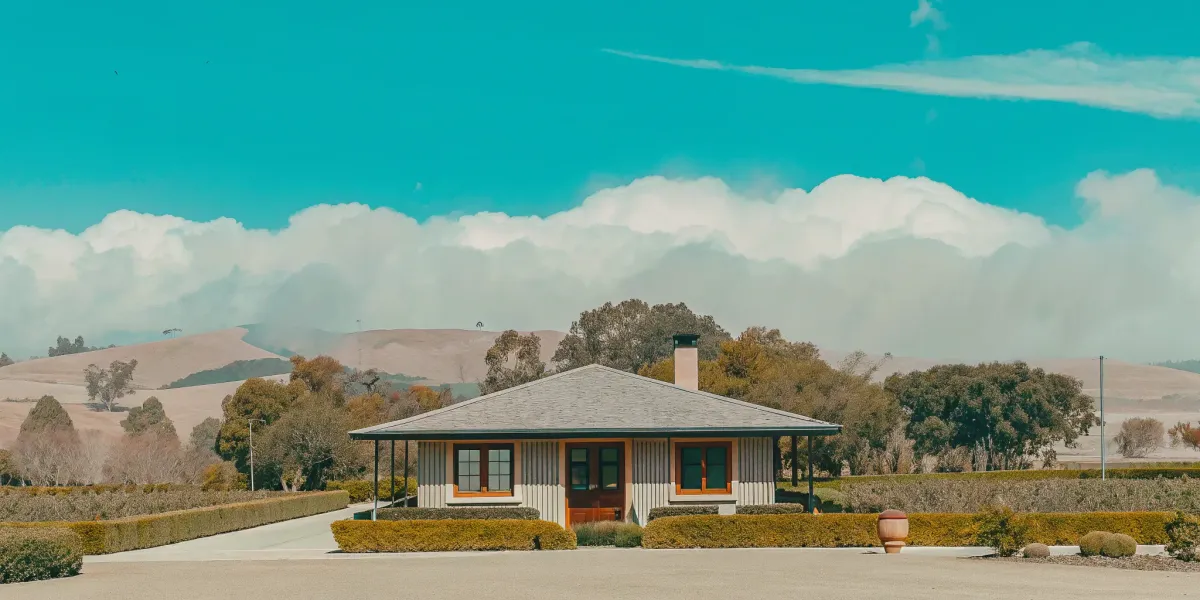
When a wildfire crew pulls up to a neighborhood, they have to make split-second decisions about which homes they can safely defend. A property with overgrown vegetation right up to the walls is a high-risk gamble, while a home with a clear, managed buffer zone is a defensible asset. Your work directly impacts their ability to protect your property. By taking proactive steps, you’re not just safeguarding your house; you’re creating a safer environment for first responders. This article will walk you through the essential steps of how to create defensible space around your home, ensuring you’ve done everything in your power to give firefighters the advantage they need.
Key Takeaways
- Master Your "Home Ignition Zone" First: Your highest priority is clearing all flammable materials—plants, mulch, and firewood—from the first five feet around your foundation. This non-negotiable step is the most effective way to stop wind-blown embers from igniting your home.
- Build Resilience from the Ground Up: True wildfire defense is about layers. Pair a fire-smart landscape using high-moisture plants with fire-resistant building materials like stucco, metal, or tile to create a property that is fundamentally harder to burn.
- Treat Defensible Space as an Insurance Strategy: This isn't a one-time project. Consistently maintain your property and document your work with photos and receipts to create a powerful record for your insurer, which is crucial for maintaining your coverage.
What Is Defensible Space and Why Does It Matter?
If you live in a wildfire-prone area, the term “defensible space” is one you’ll hear a lot. But what does it actually mean? Think of it as a buffer zone you create between your home and the surrounding wildland. According to CAL FIRE, this space is your home's first and most important line of defense against a wildfire. It’s not about clear-cutting your entire property; instead, it’s about strategically managing the vegetation to slow or stop the spread of fire.
Creating this buffer gives firefighters a safer area to work in and a better chance of saving your home. When a wildfire approaches, it looks for fuel. A yard with overgrown, dry vegetation is a direct path for flames to reach your house. By creating defensible space, you’re removing that fuel and disrupting the fire’s path. This single action is one of the most effective steps you can take to protect your property, and it’s something you have complete control over.
What Are the Three Defensible Space Zones?
To make the process manageable, experts divide defensible space into three distinct zones, each with its own set of rules. This approach helps you focus your efforts where they matter most. According to CAL FIRE’s guidelines, the zones are measured out from the walls of your home.
- Zone 0 (0-5 feet): This is the Home Ignition Zone, the most critical area. The goal here is to eliminate anything that can catch fire from embers, which are the leading cause of homes burning down in a wildfire.
- Zone 1 (5-30 feet): Known as the "Lean, Clean, and Green Zone," this area requires careful landscaping to create a buffer. You’ll want to remove dead plants and create space between trees and shrubs to reduce fuel.
- Zone 2 (30-100 feet): In this zone, the focus is on thinning out vegetation to further slow a fire’s approach and lessen its intensity.
How Defensible Space Affects Your Insurance
In California and other high-risk states, your ability to get and keep homeowners insurance is increasingly tied to your wildfire risk. Insurers are looking closely at what homeowners are doing to protect their properties, and a well-maintained defensible space is one of the first things they check for. Taking these steps shows an insurance company that you are actively working to lower your risk, which can make you a more attractive policyholder. In a tough market, having proper defensible space can be the deciding factor between keeping your coverage or facing a non-renewal. It’s a direct investment in your home’s insurability and your financial security.
The Benefits of a Well-Maintained Yard
Beyond protecting your home and helping with insurance, maintaining your defensible space offers other advantages. A thoughtfully managed landscape enhances your property’s curb appeal and can even increase its value. It doesn’t have to look sparse or barren; a fire-safe yard can still be beautiful and lush with the right fire-resistant plants. Regularly clearing dead vegetation and keeping your lawn trimmed and green not only reduces fire fuel but also creates a healthier, more pleasant outdoor environment. Most importantly, it provides peace of mind. Knowing you’ve taken proactive steps to safeguard your home can significantly reduce stress and anxiety during fire season.
How to Create Your Defensible Space Zones
Creating defensible space is your most powerful strategy for protecting your home from wildfire. Think of it as building a protective bubble around your property, designed to slow or stop an approaching fire and give firefighters a safe area to work. The process is broken down into three distinct zones, starting from your house and moving outward. Each zone has a specific purpose and a clear set of tasks.
This isn't about clear-cutting your entire property. It’s about smart, strategic landscape management. By removing flammable materials and carefully spacing out vegetation, you disrupt a wildfire’s path and reduce its intensity. The goal is to eliminate "fuel ladders"—the connections between grass, shrubs, and trees that allow flames to climb from the ground into the tree canopy. Taking a zoned approach makes the work manageable and ensures your efforts are focused where they matter most. Following these guidelines is one of the most important steps you can take to improve your home's chances of survival and maintain your insurance coverage.
Zone 0: Clear the First 5 Feet (The Home Ignition Zone)
This is the most critical area and your first line of defense. The five feet immediately surrounding your home’s foundation is where flying embers are most likely to land and ignite your house. Your goal here is to create a non-combustible barrier. Start by removing all dead leaves, pine needles, and dry vegetation from the ground, roof, and gutters. Rake this area down to the bare soil or cover it with non-flammable materials like gravel, pavers, or concrete.
Be sure to clear away any flammable items stored next to the house, such as firewood piles, recycling bins, or patio furniture. Prune any tree branches that hang over your roof or touch the sides of your home. This zone should be an ember-resistant buffer, leaving a wildfire with nothing to burn right next to your walls.
Zone 1: Create Fuel Breaks (5-30 feet)
In the area extending from 5 to 30 feet from your home, the focus shifts to breaking up the continuity of fuel. You want to create a "lean, clean, and green" landscape. This means removing dead trees and shrubs and thinning out healthy vegetation to create space between plants. Prune the lower branches of mature trees to a height of 6 to 10 feet from the ground to prevent a ground fire from climbing into the canopy.
Keep your lawn mowed to a maximum height of four inches and make sure it’s well-watered, especially during dry seasons. Arrange plants in small, separated clusters or "islands" instead of large, dense beds. This zone is all about creating fuel breaks that rob an approaching fire of its momentum and intensity before it can reach your home.
Zone 2: Reduce Fuel Ladders (30-100 feet)
The final zone extends from 30 to 100 feet out from your home, or to your property line. The objective here is to further reduce the density of vegetation to slow a fire’s spread. You don’t need to remove every tree, but you should thin them out to create adequate horizontal spacing. A good rule of thumb is to have at least 10 feet of space between the canopies of mature trees.
Focus on eliminating fuel ladders by removing smaller trees and shrubs growing beneath larger ones. Clear out fallen leaves, needles, and dead branches from the ground, as this surface fuel can carry a fire quickly. This zone acts as a crucial buffer, reducing the energy of a wildfire and decreasing the likelihood of flames reaching the more manicured area closer to your home.
Gather Your Essential Tools
Having the right equipment makes creating and maintaining defensible space much more manageable. You don’t need a shed full of professional gear, but a few key items are essential. For general cleanup, invest in sturdy leaf rakes, garden hoes, and a wheelbarrow to haul away debris. For trimming and pruning, you’ll need hand pruners for small shrubs, loppers for thicker branches, and a pole saw to safely reach high limbs.
If you have a larger property with many trees, a chainsaw can be invaluable, but only if you are trained in its safe operation. Protective gear is non-negotiable: always wear heavy-duty gloves, safety glasses, and sturdy boots to protect yourself from injury while you work.
Common Mistakes to Avoid
Creating defensible space is an ongoing commitment, not a one-time project. One of the biggest mistakes homeowners make is doing a big spring cleanup and then neglecting the property for the rest of the year. Regular maintenance is key. Another common error is forgetting to look up; clearing the ground is important, but so is cleaning your roof and gutters, where embers can easily collect and ignite.
When you clear vegetation, make sure you dispose of it properly. Don’t just move a pile of dead branches from one spot to another—that simply creates a new fuel source. Finally, pay attention to vertical spacing. Many people clear space between trees horizontally but forget to remove low-hanging branches, leaving a perfect ladder for fire to climb.
Choose Fire-Resistant Materials and Plants
Creating a defensible space goes beyond just clearing brush. The materials you use to build your home and the plants you choose for your yard play a massive role in your property’s ability to withstand a wildfire. Think of these choices as a permanent, built-in layer of protection. When embers fly, having fire-resistant materials and well-chosen landscaping can be the difference between a close call and a catastrophic loss.
Making smart, proactive decisions about your home’s structure and your garden’s layout not only enhances your family’s safety but also demonstrates to insurance companies that you are actively managing your risk. Insurers are increasingly looking for homeowners who invest in home hardening and fire-smart landscaping. By selecting the right materials and plants from the start, you’re building a more resilient property that is better prepared for wildfire and more likely to remain insurable.
Select Fire-Hardening Building Materials
The materials your home is made of are your last line of defense against embers. When building, renovating, or making repairs, always opt for non-combustible or fire-resistant options. Materials like metal, tile, brick, and stucco don't burn easily and can prevent embers from igniting your home. If you have a wood deck or siding, consider replacing it with composite materials that have a Class A fire rating.
Even small details matter. Untreated wood shakes on a roof are especially dangerous and should be avoided. If you prefer the look of wood, choose products that have been treated with fire retardant. The goal is to create a fire-hardened home that gives embers no fuel to catch on. These upgrades are an investment in your home’s long-term survival.
Plant a Fire-Smart Landscape
Your yard doesn't have to be bare to be fire-safe. A beautiful, thriving garden can also be a fire-smart one. The key is to choose high-moisture plants that resist ignition. Succulents, for example, hold a lot of water and are less likely to burn. Many native plants are also naturally adapted to dry conditions and can be more fire-resistant than imported species.
Avoid planting species that are oily, resinous, or tend to accumulate a lot of dead, dry material, like juniper, cypress, and some pines. Your local Cooperative Extension office or organizations like Fire Safe Marin can provide lists of recommended plants for your specific area. Strategic planting creates a landscape that is both beautiful and a buffer against wildfire.
What to Remove from Your Yard
Regular maintenance is one of the most effective ways to reduce your wildfire risk, and it starts with removing flammable debris. Embers can travel over a mile and easily ignite dry fuel sources around your home. Make it a habit to clear away all dead vegetation, fallen leaves, and pine needles from your roof, gutters, and the area within five feet of your home’s foundation.
This isn’t a one-and-done task. It requires consistent attention, especially during the dry season. Pay close attention to areas where debris can get trapped, like under decks, in corners, and against fences. By keeping these zones clean, you eliminate the easy fuel that a wildfire needs to get a foothold on your property.
Make Strategic Landscaping Decisions
Effective landscaping is about more than just what you plant—it’s about where you plant it. The goal is to create strategic breaks in vegetation that will slow a fire’s spread. This means avoiding "fuel ladders," where fire can climb from low-lying shrubs to taller tree branches and eventually reach your roof. You can disrupt these ladders by maintaining vertical space between the ground and the lowest tree branches.
Horizontal spacing is just as important. The amount of space you need between trees and shrubs depends on the slope of your land and the height of the vegetation. Steeper slopes require greater spacing. Following CAL FIRE’s defensible space guidelines will help you arrange your landscape to create a beautiful, effective buffer that protects your home.
Maintain Your Defensible Space Year-Round
Creating defensible space isn't a one-time project; it's an ongoing commitment to your home's safety. Vegetation grows, leaves fall, and fuel sources can accumulate over time. Maintaining your defensible space throughout the year is one of the most powerful steps you can take to protect your property from wildfire. This consistent effort also shows your insurance provider that you are proactively managing your home’s risk, which is more important than ever. By treating defensible space as routine maintenance—just like cleaning your gutters or testing smoke alarms—you can break the work into manageable tasks and ensure your home is always prepared.
Your Regular Maintenance Checklist
A consistent routine makes maintaining your defensible space feel less like a chore and more like a habit. By integrating these tasks into your regular yard work, you can keep your property in a constant state of readiness. Your top priority should always be clearing dead or dry vegetation, as this material acts as kindling for embers. This includes removing dead plants, dry grass, and fallen leaves from all defensible space zones. Regularly check the spacing between trees and shrubs to ensure you are maintaining a buffer that can slow a fire’s spread and reduce its intensity.
Follow a Seasonal Cleanup Schedule
Aligning your defensible space tasks with the seasons helps you stay ahead of peak fire season. In the spring, focus on a major cleanup before the weather gets hot and dry. This is the ideal time to remove dead vegetation that accumulated over the winter and trim back overgrown shrubs. In the fall, your primary job is to manage fallen leaves and pine needles, especially within the first five feet of your home. A thick blanket of dry leaves can become a serious fire hazard, so removing it promptly is critical for reducing your home's vulnerability.
Keep Gutters and Roofs Clear of Debris
During a wildfire, the biggest threat to most homes comes from wind-blown embers, which can travel a mile or more ahead of the flames. Your roof and gutters are prime spots for these embers to land and ignite a fire, especially if they are filled with dry leaves, pine needles, or other flammable debris. Make it a habit to clear your roof and gutters regularly. This simple, proactive step is one of the most effective ways to prevent an ember from starting a fire on your home, and it’s a task you can’t afford to skip.
Prune Trees and Manage Shrubs
Fire can easily climb from the ground into the treetops by using low-hanging branches and dense shrubs as a "fuel ladder." Breaking this ladder is a key goal of defensible space. You can create vertical spacing by pruning tree branches so they are at least six to ten feet from the ground. This prevents a ground fire from spreading into the tree canopy. At the same time, ensure there is proper horizontal spacing between individual shrubs and trees to keep a fire from jumping from one plant to the next and moving across your property.
Document Your Progress for Insurance
All the work you put into maintaining your defensible space does more than protect your home—it can also help you keep your insurance coverage. As you complete tasks, document everything. Take before-and-after photos of your property each season. Keep receipts for any professional services you use, such as tree trimming or debris hauling. This portfolio of evidence proves to insurers that you are a responsible homeowner who is actively reducing wildfire risk. This documentation can be invaluable when your policy is up for renewal. You can use a dedicated tool like the Wildfire Action Plan to organize your efforts and create a clear, shareable report for your insurance agent.
Find Resources and Support
Creating and maintaining defensible space can feel like a major undertaking, but you don’t have to do it alone. A wealth of resources is available to guide your efforts, from professional services to local government programs. Tapping into this support network can make your work more effective, save you money, and give you confidence that you’re taking the right steps to protect your home.
Get a Professional Assessment
Sometimes, you need an expert eye to see what you might miss. Hiring a certified arborist or fire mitigation professional can provide a clear, prioritized plan for your property. They can help you decide which trees and shrubs to keep or remove to maximize safety while preserving your landscape’s natural beauty. A professional defensible space assessment removes the guesswork and ensures your efforts are focused where they matter most, giving you a solid foundation for your fire preparedness strategy. This is especially helpful for large or heavily wooded properties where the task can seem overwhelming.
Connect with Your Local Fire Department
Your local fire department is one of your best allies in wildfire preparedness. They can provide specific guidance tailored to your neighborhood’s unique risks and regulations. It’s important to check local ordinances, as they are often stricter than state requirements. For example, some communities may require more clearance in Zone 1 than the standard 30 feet. Visiting your fire department’s website or attending a community meeting can provide invaluable information and connect you with local experts who want to help you succeed. Many departments offer free consultations or home assessments to get you started.
Ask About Insurance Company Programs
Your insurance carrier has a vested interest in helping you reduce your home’s wildfire risk. Many insurers offer discounts or incentives for homeowners who create and maintain defensible space. When you speak with your agent, ask specifically what mitigation efforts they recognize and how you can qualify for premium reductions. Documenting your work with photos and receipts is crucial. Proactively managing your property not only makes your home safer but can also lead to significant savings and help you maintain your insurance coverage in a challenging market.
Use Tools to Build Your Wildfire Action Plan
A well-defined plan turns good intentions into concrete actions. Defensible space is a critical component of your home’s safety, but it’s just one piece of the puzzle. A comprehensive wildfire action plan should also include evacuation routes, communication strategies, and an emergency supply checklist. Using a dedicated tool can help you organize all these moving parts. The Wildfire Action Plan platform guides you through creating a personalized, step-by-step plan, ensuring you cover all your bases and feel fully prepared long before a threat appears.
Find Grants and Cost-Saving Programs
The cost of tree removal and landscape modification can be a barrier for some homeowners, but financial assistance is often available. Many local Fire Safe Councils, state agencies, and community organizations offer grants or cost-sharing programs to help offset the expense of creating defensible space. These initiatives are designed to encourage community-wide risk reduction. A quick search for wildfire mitigation grants in your county or state can reveal programs that provide financial support for vegetation management, home hardening, and other essential fire safety improvements.
Related Articles
- Protect Your Home: Top 10 Wildfire Prevention Measures
- A Step-by-Step Home Wildfire Risk Assessment
- Wildfire Season: Why It's Now a Year-Round Threat
Frequently Asked Questions
Will creating defensible space guarantee my home will be saved in a wildfire? While there are no guarantees in a wildfire, creating and maintaining defensible space dramatically increases your home's chances of survival. It's one of the most effective actions you can take. The goal is to reduce the fire's intensity and slow its spread, which creates a safer environment for firefighters to defend your property and can even help your home withstand the flames on its own.
Do I have to clear-cut my property and make it look barren? Absolutely not. A fire-safe landscape can still be beautiful and full of life. Defensible space is about smart, strategic management, not total vegetation removal. The focus is on removing dead material, thinning out dense areas, and choosing fire-resistant plants. You can still have trees, shrubs, and a lovely garden by arranging them in a way that creates fuel breaks and prevents fire from having an uninterrupted path to your home.
I'm overwhelmed. What is the single most important area to start with? If you're just beginning, concentrate your efforts on Zone 0, which is the first five feet extending out from the walls of your home. This is the most critical area because it's where flying embers are most likely to land and ignite your house. Clear this zone of all flammable materials, including dead leaves, bark mulch, and even patio furniture. This single step creates an essential non-combustible barrier right where you need it most.
How can I prove to my insurance company that I've done this work? Documentation is key. As you work on your defensible space, take clear before-and-after photos from the same vantage points. Keep a simple log of the dates you completed tasks and save receipts for any professional services, like tree trimming. You can compile this information into a report to share with your insurance agent, demonstrating that you are proactively managing your property's risk.
What if my property ends before the 100-foot zone is complete? You are only responsible for clearing the land that you own. Your defensible space work should extend to your property line. Since wildfire doesn't stop at fences, it's a great idea to talk with your neighbors about their own efforts. When a whole community works together to reduce flammable vegetation, everyone becomes safer.
